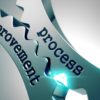More and more people are starting to realize the benefits of applying Lean process improvement methodologies outside of the manufacturing world.
In the beginning of my career, I was involved in manufacturing as well as identifying opportunities for process efficiencies and implementing process improvements on the production floor. At the time, I didn’t realize that the key learnings I gained from the production floor, such as standardization and process re-engineering, were transferable to other industries. I’ve come to realize that the belief of Lean practices being solely applicable to the manufacturing world is not only widely held but completely false.
Over the past few years, there has been an increased need for Business Process Reviews utilizing Lean in municipal, provincial and federal government bodies due to increasing efforts to reduce costs for the public. Lean is even being used in a variety of industries that range from not for profit to financial firms.
The reason why all industries can use Lean is that the underlying principles are adaptable to the business needs of any organization. Lean looks to break down silos to look at the broader system, approaches operations from a long-term business perspective that focuses on the customer and encourages continuous improvement that involves all employees.
Lean can be used in many different industries as long as its key principles are understood and applied, and business process tools are tailored to the organization. Here are a few examples of Lean tools that I used in manufacturing that can be modified and used across many industries
- Kanban Board: While working in manufacturing, I used a Kanban board to limit the work-in-progress. The same principle of limiting the amount of work to allow employees to work on the top priority tasks can be used in a service firm too. This provides a visual for planned, in progress and completed tasks for individual resources, teams or departments to ensure alignment across the organization.
- Value Stream Mapping: This tool was used to visually map the flow of production to expose waste in current processes and allowed me to identify key opportunities for operational improvement. In non-manufacturing environments, value stream mapping can be used to illustrate the flow of information to expose obstacles and inefficiencies within a process.
- Visual Controls: On the production floor, I learned about the importance of accessible and clear visual controls that illustrate the current state. As our reliance on technology has increased, we depend on our computers to store massive amounts of information but most organizations have little to no visual controls. Visual controls are tools and devices that visually help us manage or control processes. Non-manufacturing organizations can utilize visual controls to make information physical. This allows organizations to track progress, problems and results on an ongoing basis to actively make improvements to their processes.
These examples illustrate the adaptability of Lean to various industries and company needs. Now that you know that Lean can be implemented in non-manufacturing environments, it’s time to start thinking about how Lean can be implemented in your organization!
Want to implement Lean in your organization? We can help! Contact us to learn more about our services.








